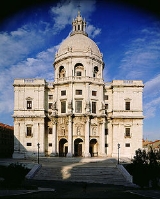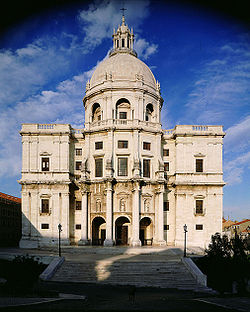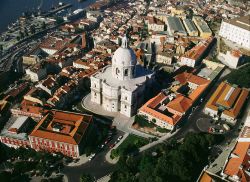
Church of Santa Engrácia
Encyclopedia

Lisbon
Lisbon is the capital city and largest city of Portugal with a population of 545,245 within its administrative limits on a land area of . The urban area of Lisbon extends beyond the administrative city limits with a population of 3 million on an area of , making it the 9th most populous urban...
, in Portugal
Portugal
Portugal , officially the Portuguese Republic is a country situated in southwestern Europe on the Iberian Peninsula. Portugal is the westernmost country of Europe, and is bordered by the Atlantic Ocean to the West and South and by Spain to the North and East. The Atlantic archipelagos of the...
. In the 20th century the church has been converted into the National Pantheon (Panteão Nacional, pɐ̃tiˈɐ̃w̃ nɐsiuˈnaɫ), in which important Portuguese personalities are buried. It is located in the neighbourhood of Alfama
Alfama
Alfama is the oldest district of Lisbon, spreading on the slope between the Castle of Lisbon and the Tejo river. Its name comes from the Arabic Al-hamma, meaning fountains or baths...
, close to another important Lisbon monument, the Monastery of São Vicente de Fora
Monastery of São Vicente de Fora
The Church or Monastery of São Vicente de Fora; meaning "Monastery of St. Vincent Outside the Walls" is a 17th century church and monastery in the city of Lisbon, in Portugal...
.
History
The current building of the Church of Santa Engrácia substituted previous churches dedicated to a martyrMartyr
A martyr is somebody who suffers persecution and death for refusing to renounce, or accept, a belief or cause, usually religious.-Meaning:...
of the city of Braga
Braga
Braga , a city in the Braga Municipality in northwestern Portugal, is the capital of the Braga District, the oldest archdiocese and the third major city of the country. Braga is the oldest Portuguese city and one of the oldest Christian cities in the World...
, Saint Engrácia
Engratia
Saint Engratia is venerated as a virgin martyr and saint. Tradition states that she was martyred with eighteen companions in 303 AD. She should not be confused with the 8th century Spanish martyr of the same name.-Legend:...
. The first church dedicated to the Saint was sponsored by Princess Maria, daughter of King Manuel I
Manuel I of Portugal
Manuel I , the Fortunate , 14th king of Portugal and the Algarves was the son of Infante Ferdinand, Duke of Viseu, , by his wife, Infanta Beatrice of Portugal...
, around 1568. In 1681, building of the current church began after previous structures collapsed. The author of the new design was João Antunes
João Antunes
João Antunes was a Portuguese architect, considered one of the most important Baroque architects of Portugal.As royal architect, Antunes' main work is the Church of Santa Engrácia in Lisbon, a Greek cross building with curved façades typical of the Baroque architecture of Borromini...
, royal architect and one of the most important baroque
Baroque
The Baroque is a period and the style that used exaggerated motion and clear, easily interpreted detail to produce drama, tension, exuberance, and grandeur in sculpture, painting, literature, dance, and music...
architects of Portugal.
Building work proceeded from 1682 through 1712, when the architect died. King John V lost interest in the church, concentrating his resources in the gigantic Convent of Mafra. The church was left unfinished until the 20th century, so that Obras de Santa Engrácia (lit. Saint Engrácia's works) has become a Portuguese synonym for long unfinished works. Eventually a dome
Dome
A dome is a structural element of architecture that resembles the hollow upper half of a sphere. Dome structures made of various materials have a long architectural lineage extending into prehistory....
was added, whereupon the church was reinaugurated in 1966.
Architecture
João Antunes prepared an ingenious design for Santa Engrácia, never before attempted in Portugal. The church has a centralised floorplan, with a Greek cross shape (a cross with arms of equal length). On each corner there is a square tower (the pinnacles were never completed), and the façades are ondulated like in the baroque designs of Borromini. The main façade has an entrance hall (galileeGalilee
Galilee , is a large region in northern Israel which overlaps with much of the administrative North District of the country. Traditionally divided into Upper Galilee , Lower Galilee , and Western Galilee , extending from Dan to the north, at the base of Mount Hermon, along Mount Lebanon to the...
) and three niches with statues. The entrance to the church is done through a beautiful baroque portal with the coat-of-arms of Portugal held by two angels. The Church has a high central dome
Dome
A dome is a structural element of architecture that resembles the hollow upper half of a sphere. Dome structures made of various materials have a long architectural lineage extending into prehistory....
which was completed only in the 20th century.

Crossing (architecture)
A crossing, in ecclesiastical architecture, is the junction of the four arms of a cruciform church.In a typically oriented church , the crossing gives access to the nave on the west, the transept arms on the north and south, and the choir on the east.The crossing is sometimes surmounted by a tower...
and naves. The floor and walls are decorated with baroque, polychromed patterns of marble. The magnificent 18th-century baroque organ was brought from Lisbon Cathedral
Lisbon Cathedral
The Patriarchal Cathedral of St. Mary Major is a Roman Catholic parish church located in Lisbon, Portugal. The oldest church in the city is the see of the Archdiocese of Lisbon. Since the beginning of the construction of the cathedral, in the year 1147, the building has been modified several...
.
National Pantheon
In 1966, during the government of the Dictator António de Oliveira SalazarAntónio de Oliveira Salazar
António de Oliveira Salazar, GColIH, GCTE, GCSE served as the Prime Minister of Portugal from 1932 to 1968. He also served as acting President of the Republic briefly in 1951. He founded and led the Estado Novo , the authoritarian, right-wing government that presided over and controlled Portugal...
, the Church of Santa Engrácia was turned into a National Pantheon. The personalities buried here include the Presidents of the Republic Manuel de Arriaga
Manuel de Arriaga
Manuel José de Arriaga Brum da Silveira e Peyrelongue was a Portuguese lawyer, the first Attorney-General and the first elected President of the First Portuguese Republic, following the abdication of King Manuel II of Portugal and a Republican Provisional Government headed by Teófilo Braga Manuel...
, Teófilo Braga
Teófilo Braga
Joaquim Teófilo Fernandes Braga ]] 24 February 1843 – 28 January 1924) was a Portuguese writer, playwright, politician and the leader of the Republican Provisional Government after the abdication of King Manuel II, as well as the second elected President of the First Portuguese Republic, following...
, Sidónio Pais
Sidónio Pais
Sidónio Bernardino Cardoso da Silva Pais was a Portuguese politician and diplomat, the fourth President in 1918. He was known as the President-King.-Family:...
and Óscar Carmona
Óscar Carmona
António Óscar Fragoso Carmona, ComC, GCA, ComSE, was the 11th President of Portugal , having been Minister of War in 1923.-Political Origin:...
, Presidential candidate Humberto Delgado
Humberto Delgado
Humberto da Silva Delgado, GCL was a General of the Portuguese Air Force and politician.Delgado was born in Brogueira, Torres Novas. He was the son of Joaquim Delgado and wife Maria do Ó Pereira and had three younger sisters, Deolinda, Aida and Lídia....
, writers João de Deus
João de Deus
João de Deus Ramos , better known as João de Deus, the greatest Portuguese poet of his generation, was born in Silves, São Bartolomeu de Messines, in the province of Algarve, son of Pedro José Ramos and wife Isabel Gertrudes Martins...
, Almeida Garrett
Almeida Garrett
João Baptista da Silva Leitão de Almeida Garrett, Viscount of Almeida Garrett was a Portuguese poet, playwright, novelist and politician. He is considered to be the introducer of the Romanticism in Portugal, with the epic poem Camões, based on the life of Luís de Camões...
, Guerra Junqueiro
Guerra Junqueiro
Abilio Manuel Guerra Junqueiro was a Portuguese, bachelor in law at the University of Coimbra, a top civil servant, member of the Portuguese House of Representatives, journalist, author, and poet. His work helped inspire the creation of the Portuguese First Republic...
and Aquilino Ribeiro
Aquilino Ribeiro
Aquilino Gomes Ribeiro, ComL was a Portuguese writer and diplomat. He is considered as one of the great Portuguese novelists of the 20th century. He was nominated for the Nobel Literature Prize in 1960....
and fado singer Amália Rodrigues
Amália Rodrigues
Amália da Piedade Rodrigues, GCSE, GCIH, , also known as Amália Rodrigues was a Portuguese singer and actress.She was known as the "Rainha do Fado" and was most influential in popularizing the fado worldwide. She was one of the most important figures in the genre's development, and enjoyed a...
. There are cenotaph
Cenotaph
A cenotaph is an "empty tomb" or a monument erected in honour of a person or group of people whose remains are elsewhere. It can also be the initial tomb for a person who has since been interred elsewhere. The word derives from the Greek κενοτάφιον = kenotaphion...
s to Luís de Camões
Luís de Camões
Luís Vaz de Camões is considered Portugal's and the Portuguese language's greatest poet. His mastery of verse has been compared to that of Shakespeare, Vondel, Homer, Virgil and Dante. He wrote a considerable amount of lyrical poetry and drama but is best remembered for his epic work Os Lusíadas...
, Pedro Álvares Cabral
Pedro Álvares Cabral
Pedro Álvares Cabral was a Portuguese noble, military commander, navigator and explorer regarded as the discoverer of Brazil. Cabral conducted the first substantial exploration of the northeast coast of South America and claimed it for Portugal. While details of Cabral's early life are sketchy, it...
, Afonso de Albuquerque
Afonso de Albuquerque
Afonso de Albuquerque[p][n] was a Portuguese fidalgo, or nobleman, an admiral whose military and administrative activities as second governor of Portuguese India conquered and established the Portuguese colonial empire in the Indian Ocean...
, Nuno Álvares Pereira
Nuno Álvares Pereira
Dom Nuno Álvares Pereira, O. Carm. , also spelled Nun'Álvares Pereira, was a Portuguese general of great success who had a decisive role in the 1383-1385 Crisis that assured Portugal's independence from Castile...
, Vasco da Gama
Vasco da Gama
Vasco da Gama, 1st Count of Vidigueira was a Portuguese explorer, one of the most successful in the Age of Discovery and the commander of the first ships to sail directly from Europe to India...
and Henry the Navigator.

